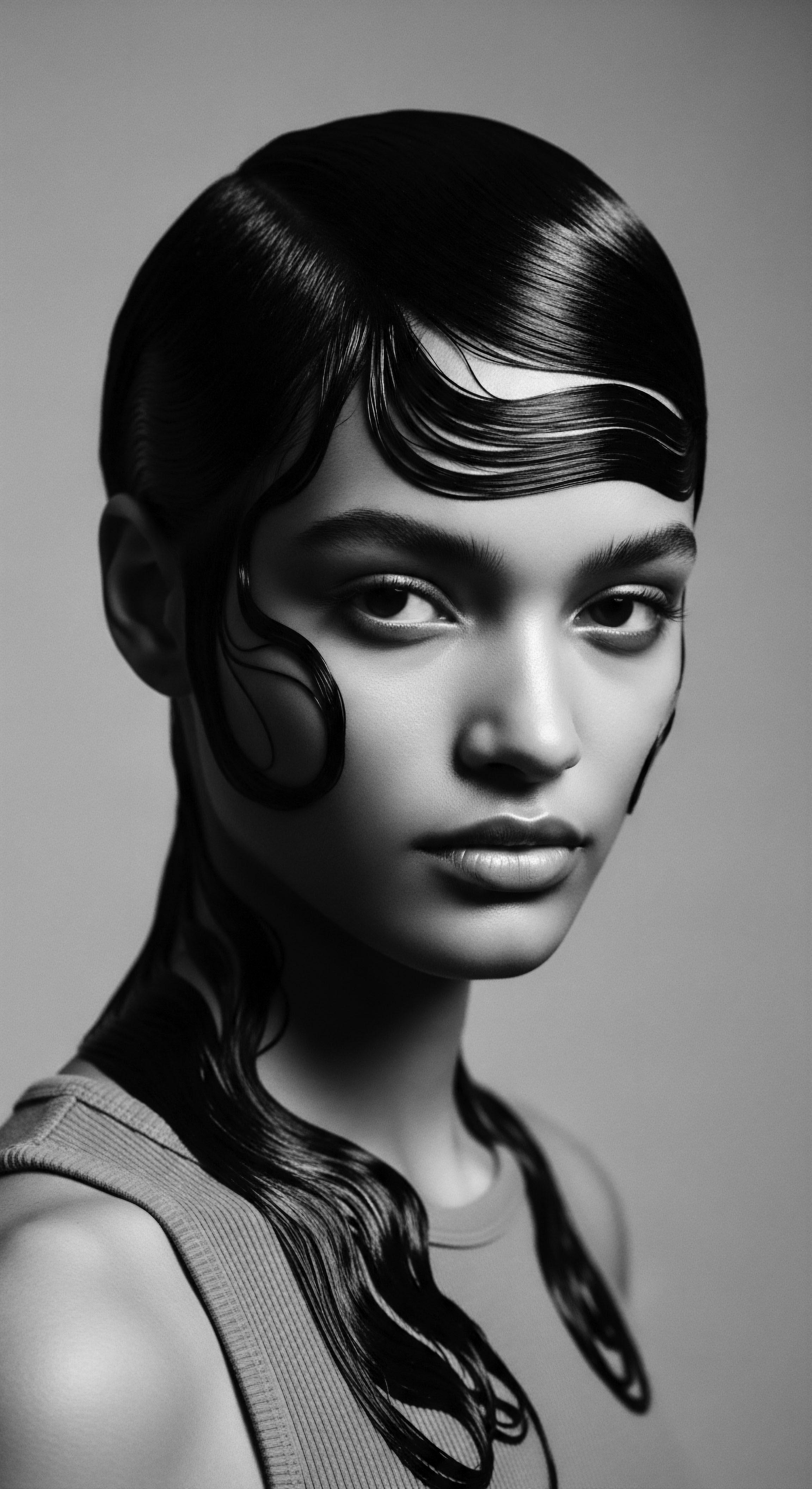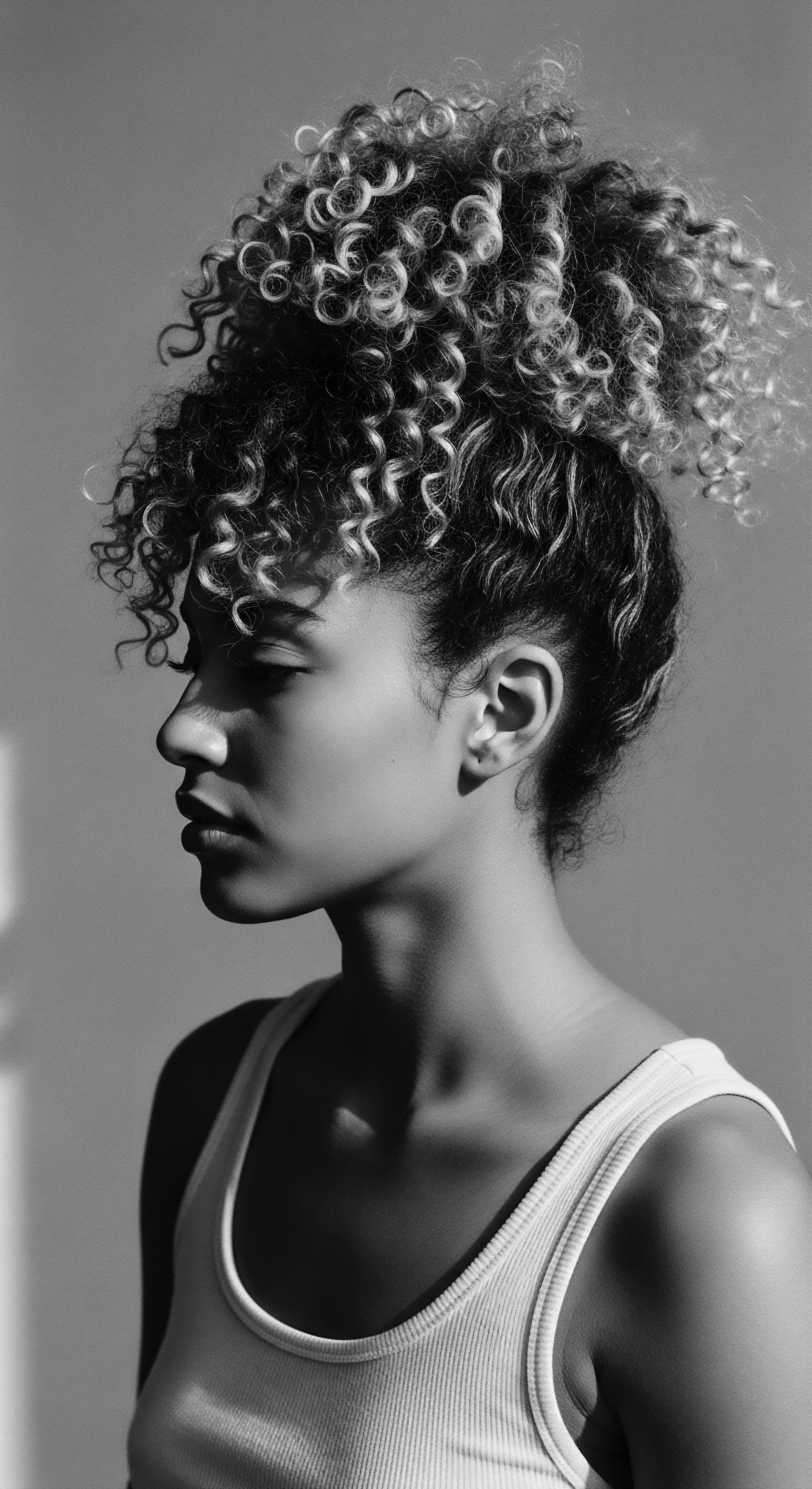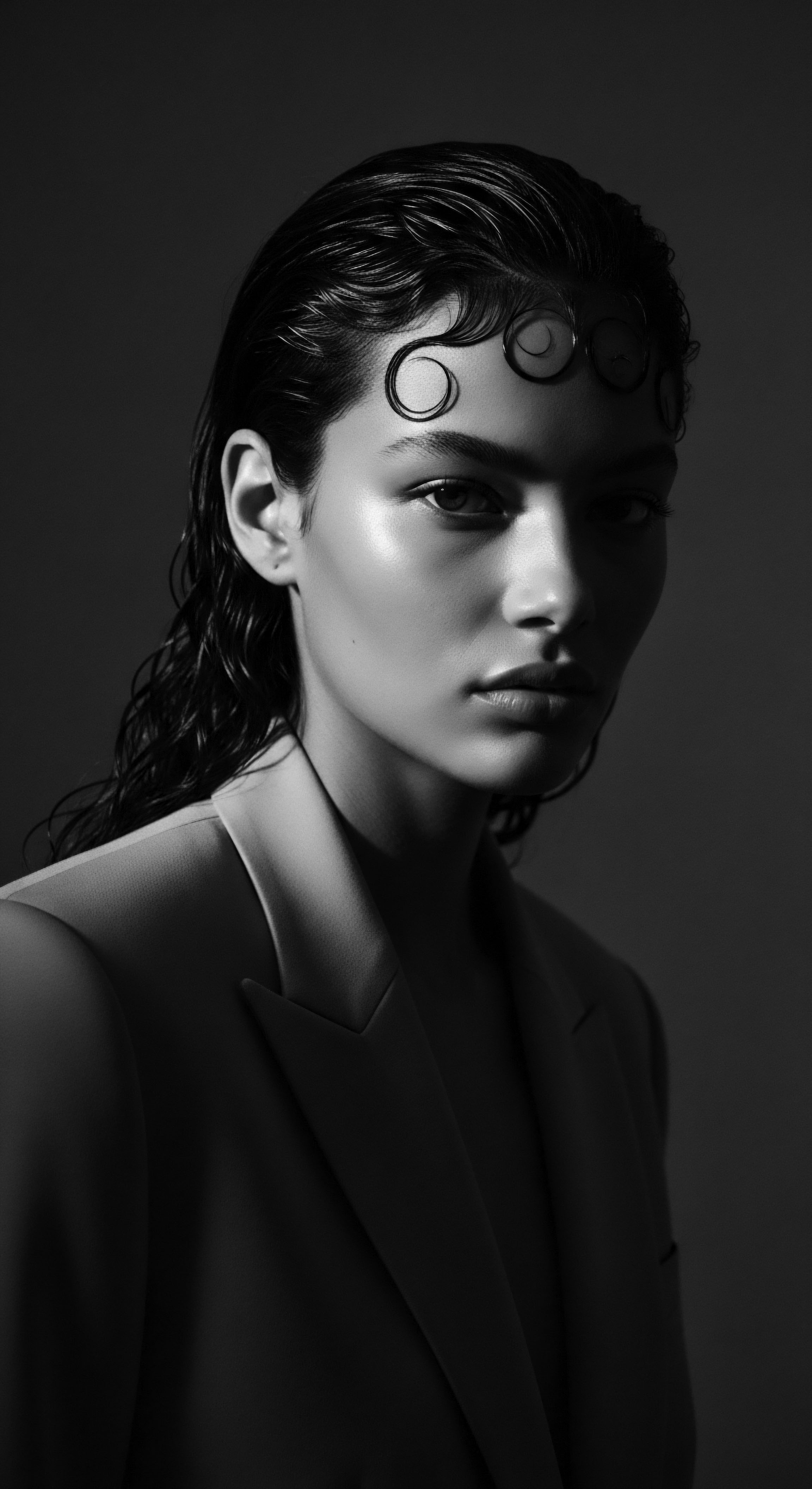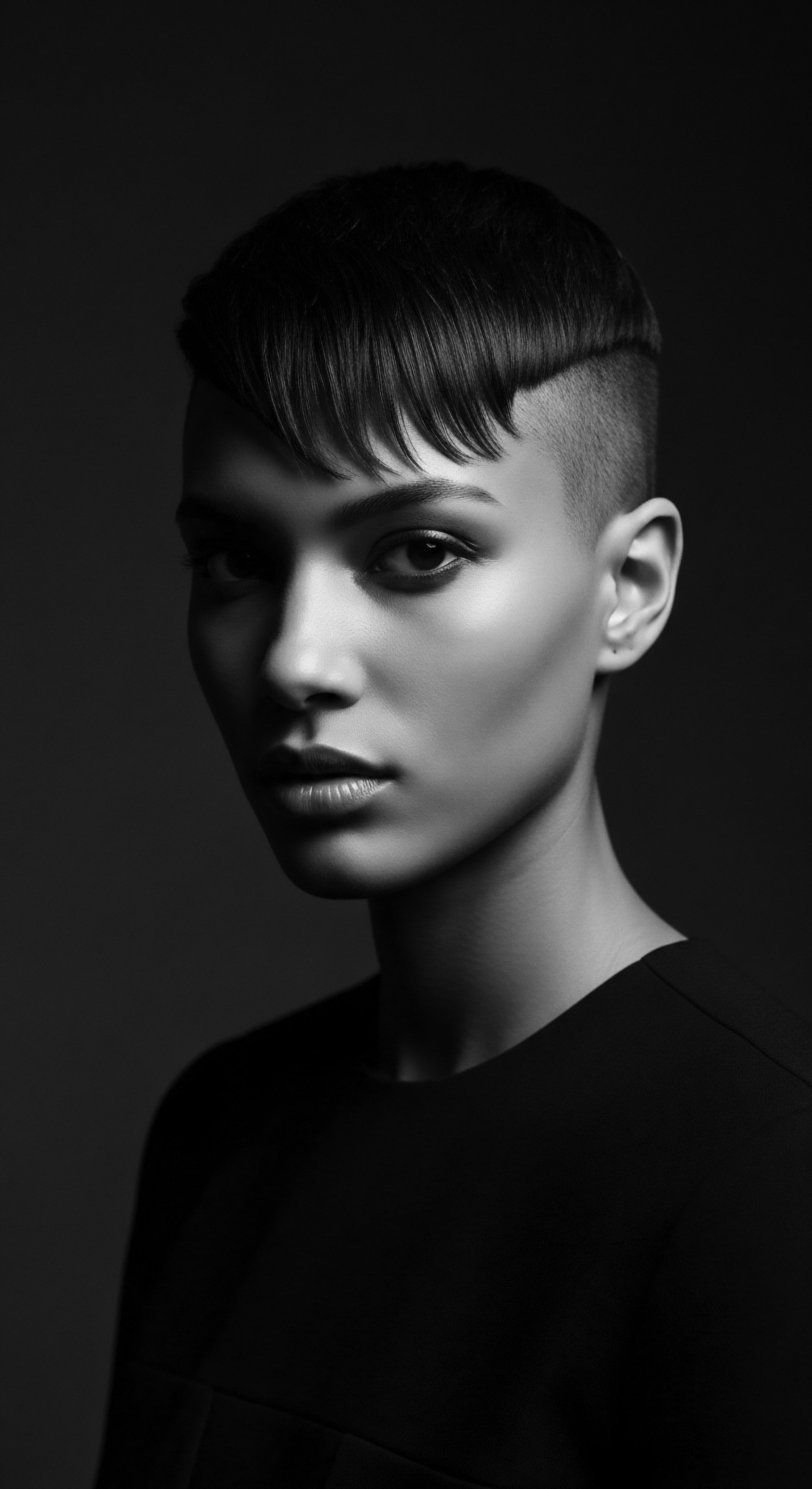
Roots
The story of textured hair, for so many, is not merely a tale of strands and follicles. It is a chronicle whispered through generations, a vibrant lexicon of survival, beauty, and steadfast identity. Our hair, in its myriad coils and intricate patterns, has always been a living archive, a repository of ancestral knowledge and quiet defiance. To speak of chemical relaxers, then, and their scientific consequences on these revered strands, calls for a careful tracing of paths—from the microscopic architecture of each curl to the sweeping cultural currents that shaped practices across time.
Consider the elemental biology of textured hair, a marvel of biological engineering. Unlike straight hair, which generally presents a circular cross-section, the elliptical shape of a textured hair strand, along with its varied twists and bends, dictates its characteristic coiling. This unique morphology means the cuticle, the outermost protective layer of overlapping scales, does not lie as flat or smooth as it would on a straight strand. These lifted scales, an inherent feature of the curl, render textured hair more susceptible to environmental factors, mechanical stress, and, significantly, chemical manipulation.
The cortex, the central body of the hair responsible for its strength and elasticity, is rich in keratin proteins and disulfide bonds, the very architecture that gives hair its structural integrity and its capacity for spring. The medulla, the innermost core, may be discontinuous or absent in finer textured strands. This intricate internal structure, so perfectly adapted to its original contexts—perhaps providing insulation or protection under varied climates—becomes a delicate canvas when subjected to harsh, high pH interventions.
Textured hair, a living chronicle of ancestral knowledge, possesses a unique elliptical structure that renders its protective layers more susceptible to external influences.
For millennia, care of these distinctive hair types was an integral part of communal life and individual expression within Black and mixed-race communities. Ancient African hair traditions were replete with practices that honored and preserved the hair’s natural state. We see evidence in historical accounts and archaeological finds of sophisticated braiding techniques, intricate adornments, and the extensive use of natural emollients drawn from the land. These were not simply cosmetic acts; they were rituals deeply interwoven with social status, spiritual belief, and communal belonging.
For instance, in many West African cultures, hairstyling was an art form passed down through matriarchal lines, with specific styles conveying marital status, age, or even tribal affiliation. These practices were rooted in a profound understanding of the hair’s natural resilience and its need for gentle nourishment, a far cry from the chemical interventions that would later arrive on distant shores.

Understanding the Hair Shaft Structure
To truly grasp the impact of high pH relaxers, one must peer into the very fabric of the hair itself. Each hair fiber, an appendage of the skin, emerges from a follicle, but its composition varies in ways that are crucial to its response to chemical treatments. Textured hair, by virtue of its helical growth pattern, experiences natural stress points where the curl bends sharply. These bends represent areas where the cuticle scales may be slightly more raised or vulnerable.
- Cuticle ❉ This is the hair’s first line of defense, a shingle-like exterior layer composed of dead, flattened cells. Its purpose ❉ to protect the inner cortex from damage. In textured hair, these scales often do not lie perfectly flat, contributing to its characteristic volume and sometimes its perceived dryness, as moisture can escape more readily.
- Cortex ❉ The bulk of the hair fiber, residing beneath the cuticle, is the cortex. It is packed with keratin macrofibrils and microfibrils, which are long chains of protein wound together. The strength and elasticity of hair come predominantly from this layer, especially from the numerous disulfide bonds that cross-link the keratin chains. These chemical bonds are the primary target of relaxers.
- Medulla ❉ The innermost core, the medulla, is often discontinuous or absent in finer textured hairs. Its exact function in human hair is not fully clear, but it contributes to the hair’s overall diameter.
The inherent coily pattern means that oils produced by the scalp, known as sebum, struggle to travel down the length of the hair shaft. This physiological reality contributes to the natural dryness often experienced by individuals with textured hair, a dryness that chemical processes will only exacerbate. The hair’s natural pH, typically slightly acidic (around 4.5-5.5), helps to keep the cuticle scales closed and smooth, maintaining integrity. When this delicate balance is disturbed, particularly by highly alkaline substances, the protective mechanisms of the hair are severely compromised.

Historical Glimpses of Hair Alteration
While chemical relaxers are a modern invention, the desire to alter hair texture is not new. Across diverse cultures, hair has been manipulated for aesthetic, social, and spiritual reasons. However, the methods employed historically were, by and large, non-destructive, relying on physical tension, natural ingredients, and time.
Clay mixtures, plant-based dyes, and various forms of braiding or wrapping were common. Yet, the specific historical context of textured hair alteration, particularly within the Black diaspora, took a distinctly painful turn with the advent of European beauty standards and the trauma of slavery.
The pressure to conform, to make one’s hair appear straighter or more “manageable,” gained currency in a world that often equated Blackness with inferiority and otherness. The hot comb, a precursor to chemical relaxers, emerged in the late 19th and early 20th centuries as an accessible if damaging tool for temporary straightening. Its use often resulted in burns to the scalp and irreversible heat damage. This paved the way for chemical formulations, promising a more permanent solution to the perceived “problem” of textured hair.
The scientific understanding of the hair’s chemistry was still rudimentary, but the societal demand was powerful. These early chemical straighteners, often crude and dangerous, marked a significant departure from ancestral practices centered on nourishment and respect for the hair’s natural state. The very concept of chemically altering one’s hair to align with a dominant aesthetic was, in itself, a profound cultural consequence, long before the scientific ramifications were fully understood.

Ritual
The act of applying a relaxer, for many generations, evolved into a complex, almost sacred ritual. It was a rite of passage for countless young Black girls, a Saturday afternoon spent in bustling kitchens or salons, the sharp, pungent scent of chemicals filling the air. This weekly or bi-weekly cadence of transformation was not merely about cosmetic change; it was a profound interaction with identity, community, and the persistent, often unspoken, pressures of belonging in a world that seldom celebrated natural texture. The societal expectation that hair should be straight, smooth, and easily tamed for school, work, or social acceptance, shaped decisions for millions, pushing scientific understanding to the background for a time.
At the heart of this ritual lies a potent chemical reaction. High pH relaxers, most commonly “lye” relaxers containing sodium hydroxide (NaOH), operate on a simple yet destructive principle ❉ they break the very bonds that give textured hair its unique strength and curl. The pH of these solutions is exceptionally high, often exceeding 12.0, creating an extremely alkaline environment.
For context, occupational safety regulations classify a pH of 10.5 as an irritant and 11.5 as corrosive to skin (Sishi, Van Wyk, & Khumalo, 2019). Imagine the effect of such a substance on delicate hair fibers and the sensitive scalp.

The Alkaline Assault on Hair Bonds
When the relaxer cream is applied, its high alkalinity causes the hair shaft to swell, forcing open the tightly packed cuticle scales . This allows the active chemical agent to penetrate deep into the cortex. Inside the cortex, the sodium hydroxide molecules attack the disulfide bonds , which are the strong covalent linkages between cysteine amino acids that hold the keratin protein chains together. These bonds are responsible for the hair’s resilience, elasticity, and its natural curl pattern.
The alkaline solution breaks these sulfur-sulfur bonds, converting some of the cysteine to lanthionine, a new amino acid with a single sulfur atom. This process, known as lanthionisation , permanently alters the protein structure.
Unlike perms, which reform disulfide bonds into a new pattern, relaxers effectively eliminate many of these bonds, dramatically weakening the hair’s internal structure. The hair loses its ability to recoil and instead lies flat. The degree of bond breakage is directly proportional to the strength of the relaxer and the time it remains on the hair. Over-processing, a common occurrence due to attempts to achieve extreme straightness or inconsistent application, leads to excessive bond disruption.
High pH relaxers, by their very design, break the disulfide bonds within the hair’s core, irreversibly altering its natural coil and compromising its strength.
The immediate consequences of this chemical restructuring are manifold.
- Protein Degradation ❉ The high pH denatures the keratin proteins within the cortex. This is similar to how extreme heat can change the structure of proteins, making them less robust and more susceptible to damage. The hair loses its inherent strength and becomes noticeably weaker.
- Cuticle Erosion ❉ The repeated forced opening and damage to the cuticle scales leave the hair’s outer layer rough, porous, and highly vulnerable. This porous state makes the hair less able to retain moisture, leading to chronic dryness and a dull appearance. It also increases friction between strands, contributing to tangling and breakage.
- Reduced Elasticity ❉ Healthy hair possesses a natural springiness that allows it to stretch and return to its original shape. Relaxed hair, with its broken internal bonds, loses this elasticity. It becomes limp and lifeless, snapping easily under even minimal tension, such as during combing or styling.
- Moisture Imbalance ❉ The compromised cuticle and denatured proteins struggle to hold water, leading to perpetual dehydration. This dryness contributes to a brittle texture, making the hair prone to fracture, especially at the ends. The hair feels rough to the touch, a stark contrast to the natural softness of healthy, well-hydrated textured coils.
Beyond the hair shaft itself, the scalp, a delicate ecosystem, faces its own assault. The corrosive nature of high pH relaxers often causes chemical burns, characterized by redness, stinging, scabbing, and, in severe cases, weeping lesions. These burns, colloquially known as “scabs” or “relaxer bumps,” are not merely discomforts; they are indicators of significant tissue damage. The pain was often endured, framed as a necessary discomfort for the desired outcome, a testament to the immense pressures felt by those pursuing straightened hair.

The Weight of Expectation and the Cost of Conformity
The societal narrative surrounding textured hair, particularly in the mid-20th century, cast natural coils as unprofessional, unkempt, or unruly. This pervasive message, a bitter legacy of colonial beauty standards, meant that the “ritual” of relaxing became a pathway to perceived acceptance and upward mobility. Many felt they had little choice but to conform, to chemically alter a part of themselves that was, in its natural state, a powerful link to African heritage and identity. The scientific consequences, while dire, were often secondary to the immediate social consequences of non-conformity.
The salons, or home kitchens where relaxers were applied, became spaces of shared experience, of both aspiration and silent suffering. Women and girls learned to sit through the burning sensation, to endure the chemical smell, all for the promise of straight hair. This shared endurance forged a particular kind of community, one built on a collective understanding of the sacrifices required to navigate a world hostile to natural Black beauty. The scientific assault on the hair mirrored, in a way, the societal assault on the inherent beauty of diverse hair textures.

Relay
The immediate, visible effects of high pH relaxers are but the first chapter in a longer, more complex story of consequences that unfold over time. The structural compromises initiated by chemical alteration do not vanish; rather, they compound with each subsequent application, creating a cycle of damage that often culminates in chronic hair fragility and, for many, significant hair loss. The relay of this understanding, from whispered warnings in salon chairs to rigorous scientific inquiry, highlights the deep resonance of hair health within Black and mixed-race communities , prompting a powerful re-evaluation of heritage and wellness.

Cumulative Damage and Long-Term Consequences
Repeated applications of relaxers mean that previously treated hair, already weakened, is re-exposed to corrosive chemicals. Even with careful “new growth only” application, the overlap is inevitable, leading to what is often termed “over-processed” hair. This cumulative damage manifests in several critical ways:
- Chronic Breakage ❉ The loss of elasticity and structural integrity means the hair is continuously prone to breaking, not just at the ends, but often mid-shaft. This results in hair that struggles to gain length, appearing perpetually stunted or thin despite growth from the scalp. The delicate nature of relaxed hair means everyday actions—combing, styling, even simply moving—can lead to fracture.
- Thinning Hair Density ❉ While individual strands break, the cumulative effect over years of relaxer use can lead to a noticeable reduction in overall hair density. This is partly due to breakage and partly due to damage to the hair follicles themselves, particularly from repeated scalp burns. The inflammatory response triggered by chemical irritation can, over time, scar the follicle, leading to a permanent inability to produce hair.
- Chemical-Induced Alopecia ❉ One of the most severe consequences is the development of various forms of alopecia (hair loss). The most widely recognized is Central Centrifugal Cicatricial Alopecia (CCCA) , a form of scarring hair loss predominantly affecting the crown of the scalp in Black women. While the precise etiology of CCCA is complex and involves genetic predispositions, repetitive chemical and heat trauma, often from relaxers, is a significant contributing factor. The inflammation caused by the relaxer burns the scalp, and this chronic inflammation can lead to fibrous tissue replacing healthy hair follicles, causing irreversible bald patches. Studies, such as those by Khumalo et al. (2010), demonstrate that chemically treated hair exhibits a reduced cystine content, consistent with the fragile, damaged hair seen in genetic disorders like trichothiodystrophy. This scientific finding directly supports the observation of increased fragility and breakage in relaxed hair.
Other forms of hair loss, such as traction alopecia , can also be exacerbated. When relaxed hair, already weakened, is then subjected to tight pulling from braids, weaves, or ponytails, the combined stress on the hair follicles can accelerate hair loss along the hairline and nape. This intertwining of chemical and mechanical damage presents a particularly challenging problem for individuals navigating hair care choices.

The Weight of Data and the Shift in Perspective
The scientific understanding of these consequences has slowly accumulated, often driven by dermatologists and researchers working directly with affected populations. Initial anecdotal observations from salon professionals and individuals experiencing hair damage eventually spurred more rigorous investigations. For instance, a study by Sishi, Van Wyk, and Khumalo (2019) meticulously examined the pH of hair relaxers sold on the South African market, finding that the median pH of all tested relaxers (including those advertised for children) was a staggering 12.36 (interquartile range 12.10 – 12.62).
This stark quantitative data unequivocally confirms that these products operate at levels considered corrosive to human skin, directly translating to corrosive damage for the hair shaft and scalp over time. The persistent use, often every 4-7 weeks as documented by user habits, perpetuates this corrosive exposure.
| Hair Component Cuticle |
| Natural State ❉ Ancestral Understanding Protective outer layer, unique lifted scales aid volume and protect inner fiber. Traditionally oiled and smoothed with natural conditioners. |
| Relaxer Impact ❉ Scientific Consequences Forced open by high pH; scales lift, crack, or erode. Leads to increased porosity, dryness, and vulnerability to external damage. |
| Hair Component Cortex (Keratin & Disulfide Bonds) |
| Natural State ❉ Ancestral Understanding Strong internal structure provides resilience and curl memory. Ancestral practices respected and nourished this core. |
| Relaxer Impact ❉ Scientific Consequences Disulfide bonds broken irreversibly, leading to protein denaturation and lanthionisation. Results in loss of elasticity, permanent weakening, and straightness. |
| Hair Component Scalp |
| Natural State ❉ Ancestral Understanding Foundation of hair health; traditionally nourished with herbs and gentle massages to promote growth. |
| Relaxer Impact ❉ Scientific Consequences Vulnerable to chemical burns, inflammation, and scarring. Chronic irritation can lead to follicular damage, impacting future growth and contributing to alopecia. |
| Hair Component The scientific consequences of relaxers are a stark contrast to the historical wisdom of nourishing textured hair, exposing a legacy of damage alongside desired cosmetic change. |

How Did Scientific Inquiry Confirm Long-Held Observations of Damage?
The journey from casual observation to scientific consensus regarding relaxer damage has been a slow but steady relay. For decades, Black women, their hairdressers, and concerned family members noted the persistent breakage, thinning, and scalp irritation associated with relaxer use. These observations, often dismissed as mere cosmetic complaints or attributed to improper application, were the first empirical data points. Scientists later began to systematically investigate the chemical alterations.
Electron microscopy revealed the dramatic changes to the cuticle layer, showing chipped, missing, and malformed scales on relaxed hair. Chromatographic analysis confirmed the irreversible breaking of disulfide bonds and the formation of lanthionine, a signature of relaxer action. The measurable reduction in amino acids critical for hair strength, such as cystine, in relaxed hair (Khumalo et al. 2010) provided concrete biochemical proof of the hair’s compromised state.
This scientific validation provided a new language to articulate what was, for many, a lived reality. It underscored the biological costs incurred in pursuit of a particular aesthetic, prompting a societal shift. The natural hair movement, gaining momentum in the late 20th and early 21st centuries, represents a powerful cultural and social relay—a conscious decision to return to and celebrate the inherent qualities of textured hair.
It stands as a profound re-alignment with ancestral heritage, a recognition that the beauty and health of one’s hair should not require chemical sacrifice. The scientific findings on relaxer damage served as a foundational pillar for this movement, offering tangible reasons for embracing natural textures beyond mere aesthetics.
This cultural pivot is not simply a trend; it is a profound reclamation of self and history. It acknowledges that hair, in its unadulterated form, is a valid and beautiful expression of identity and lineage . The scientific data, therefore, did not just explain damage; it empowered a return to practices that echo ancestral wisdom, where hair care prioritized preservation over alteration, and where the coil, kink, and curl were revered as symbols of uniqueness and connection.

Reflection
The intricate dance between science and heritage finds its compelling rhythm in the story of textured hair and the enduring legacy of high pH relaxers. What began as a chemical solution to a societal pressure has, through diligent scientific inquiry and a powerful reawakening of cultural pride, revealed its true cost ❉ a biological alteration with profound implications for the health of hair and scalp. Yet, this narrative is not one of mere damage; it is also a testament to resilience, a beacon guiding a return to self-acceptance and ancestral wisdom.
Each strand of textured hair, with its unique convolutions and inherent strength, carries within it the echoes of countless generations. The choices made about its care, from the earliest braiding patterns to the modern embrace of natural styles, are deeply personal acts that resonate with a collective past. Understanding the scientific consequences of high pH relaxers is more than just biochemical knowledge; it is an act of historical reckoning, acknowledging the forces that pushed many towards practices that undermined the very vitality of their hair. It is also an act of empowerment, providing the information necessary to make choices that honor the body’s natural design and respect the hair’s ancestral blueprint.
The journey through relaxer consequences ultimately leads to a reclamation of ancestral wisdom, celebrating the inherent beauty and strength of textured hair.
The soul of a strand, then, reveals itself not only in its microscopic structure but in its capacity to hold stories—stories of struggle, of adaptation, and, ultimately, of triumphant return. The journey away from the harsh alkaline touch of relaxers towards restorative, heritage-informed care is a poignant expression of this soul. It signifies a profound shift from conforming to external ideals to cherishing an inherent, inherited beauty. In every coil now celebrated, in every protective style rooted in tradition, we see the living archive of textured hair continuing its vibrant story, unbound and resilient, forever connected to its rich past and its promising future.

References
- Sishi, V. N. B. Van Wyk, J. C. & Khumalo, N. P. (2019). The pH of lye and no-lye hair relaxers, including those advertised for children, is at levels that are corrosive to the skin. S Afr Med J, 109(12), 941–946.
- Khumalo, N. P. Stone, J. Gumedze, F. McGrath, E. Ngwanya, M. R. & de Berker, D. (2020). ‘Relaxers’ damage hair ❉ Evidence from amino acid analysis. J Am Acad Dermatol, 62(3), 402–408.
- McMichael, A. J. & Khumalo, N. P. (2019). Hair Relaxer Use ❉ A Medical Perspective. Journal of Clinical and Aesthetic Dermatology, 12(11), 32–37.
- Dawber, R. (1974). Knotting of scalp hair. Br J Dermatol, 91(2), 169-173.
- Khumalo, N. P. Doe, P. T. Dawber, R. P. R. & Ferguson, D. J. P. (2000). What is normal black African hair? A light and scanning electron-microscopic study. J Am Acad Dermatol, 43(5 Pt 1), 814–820.
- de Sá Dias, T. C. Baby, A. R. Kaneko, T. M. & Robles Velasco, M. V. (2007). Relaxing/straightening of Afro-ethnic hair ❉ historical overview. J Cosmet Dermatol, 6(1), 2–5.
- Mamabolo, T. Agyei, N. M. & Summers, B. (2013). Cosmetic and amino acid analysis of the efects of lye and no-lye relaxer treatment on adult black female South African hair. J Cosmet Sci, 64(4), 287–296.
- Olsen, E. A. Callender, V. McMichael, A. Sperling, L. Anstrom, K. J. Shapiro, J. & al. (2011). Central hair loss in African American women ❉ Incidence and potential risk factors. J Am Acad Dermatol, 64(2), 245–252.
